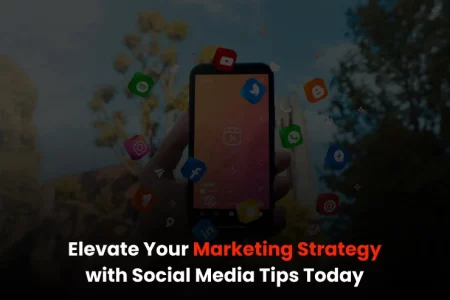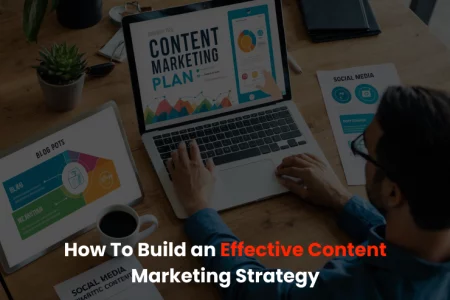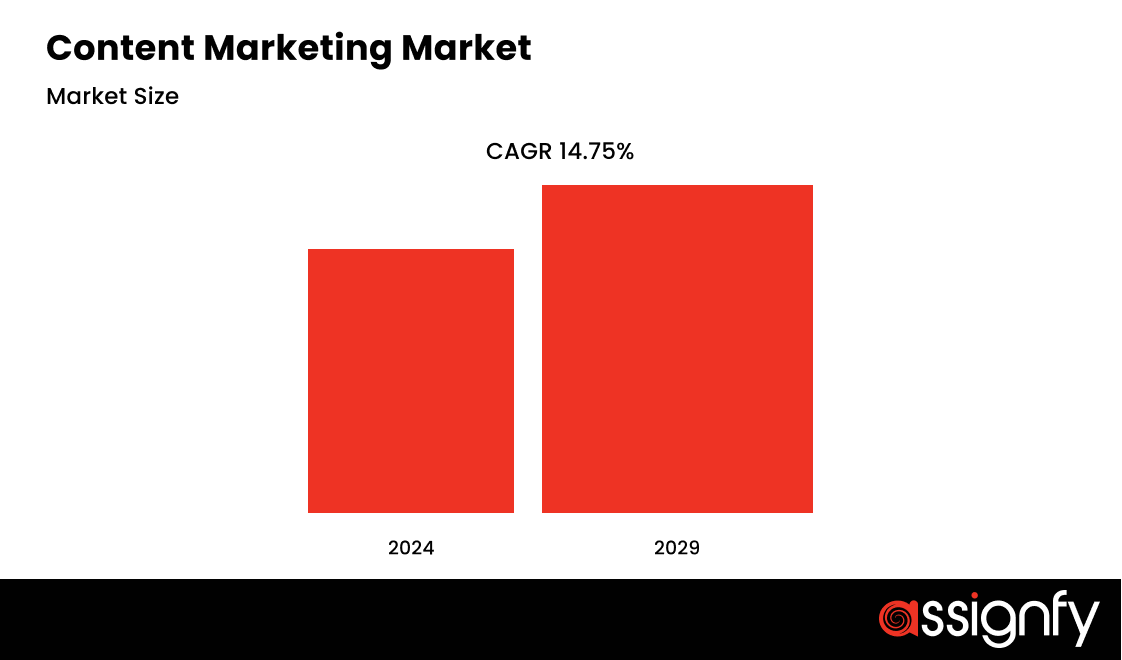Digital Marketing
How To Build an Effective Content Marketing Strategy
Content marketing, which incorporates creating and sharing useful content with your audience, is a form of marketing and one of the most efficient ways to grow your business if done right. Robust content marketing ensures that your business will succeed.
As per Mordorintelligence, the content marketing market size is projected at USD 263.09 billion in the current year. It is estimated to reach USD 523.45 billion in the next five years, recording a CAGR of 14.75% during the forecast period.
Regardless of how long you have been using a similar approach, it never hurts to revisit your content strategy to ensure it is inventive and captivating for your upcoming and existing customers. If you’re having trouble preparing for the future year or need some new ideas to make a part of your plan, then continue reading.
What is a content strategy?
A content strategy refers to the planning, creation, publication, management, and authority of content. A great content strategy will draw and engage a target audience, aligning with their requirements while driving business objectives.
At a high level, a good content strategy must involve the following information:
- Definite goals (i.e., what exactly you want to accomplish through your content)
- Audience insights (i.e., who your content is for)
- Content types (i.e., what type of content you’ll create)
- Promotion plan (i.e., how you’ll allot your content)
If we try to make you understand a content strategy, then it is as if your business goals involve increasing brand awareness.
To achieve this, you might apply a content strategy that emphasizes SEO to increase your website’s transparency over the SERPs while driving traffic to your products or services. In the beginning, a new business owner might believe that a content strategy is nice to have but not important. Still, creating content of high quality is central to gaining the assurance of new viewers and taking business to its long-term success.
A good content strategy lies at the base of your enticing and amusing stages in a buyer’s journey, followed by an inbound marketing outline. Besides attracting potential customers to your brand, you can leverage a content strategy for sales assistance and customer satisfaction.
Grow your brand with smart content marketing strategy
Share Your Vision with Our Marketing Experts
Let's ConnectWhy have a Content Marketing Strategy?
Without an administrative strategy, content marketing efforts can feel chaotic. But a comprehensible strategy has numerous benefits:
- It aligns your content with business aims. So you don’t waste assets generating something that has no worth for your company.
- It facilitates attaining support from stakeholders by letting senior leadership and management know-how beneficial your content marketing initiatives are.
- It simplifies your content creation and distribution processes. You can plan, publish, and promote your content more effectively and productively.
- It lets you examine and optimize your results over time. Besides, it allows measuring and tracking your content performance to adjust the strategy needed to fulfill your goals.
Steps to Create a Successful Content Marketing Strategy
Here are the steps involved in the creation of a robust and successful content marketing strategy.
-
Earn Organizational Buy-In
Successful content marketing programs are highly cooperative and do not start off with barriers. To ensure that the program investment makes sense, you must first create a documented business case in order to get to that point. And just because everyone is performing content marketing doesn’t mean you should, too.
Creating a successful business case comprises the cost of creating content, the use of content, and its evaluation. Remember to include why you’re making content, how it will enhance the business, and who will own the results. This essential first step will help you compact your scope before being dragged in a million directions by thousands of external content demands.
-
Develop Your Brand Story
To build a successful content marketing program, you should define who you’re attending and why. Determine who your target audience is and look into the pain points that you’re attempting to solve in detail. It doesn’t matter if you’re building out your personas, prototypes, or ideal customer profiles. What matters most is responding to the following questions:
- What is the client’s problem?
- What is the client’s current state?
- How do you resolve that problem?
- What is your client’s ideal future state?
Once you’ve collected your research, start crafting your narrative. Where do you stand in a competitive setting? In what way does your product deviate from the norm? How are you certainly influencing the world? Creating a vibrant brand story will give new life to your content campaigns and help you create an integrated message throughout all your content campaigns.
-
Identify Your Key Channels
While some marketers might argue that you should build content on every possible platform, a lack of concentration will take you toward failure. Instead, classify the three most prevalent channels where your key audience lives and find ways to build honestly valuable content on each exclusive platform. Identify what content formats are most effective by looking into relevant competitors, influencers, and hashtags to imitate their success.
The following platforms will serve as your key distribution channels, most importantly: So, any time you create a new piece of content, you can dispense and reformulate each piece with this in mind.
-
Conduct topical Research
By now, you should have a stable consideration of your customer’s utmost pain points. To decode this into what content to create, perform a mix of topical research processes. Nothing beats talking directly with your customers. Researching keywords is a great place to begin if you don’t have access to these discussions.
There are numerous online tools that are accessible to help you find research topics.
Additionally, you can look at apps like Quora or Reddit to recognize the most frequently asked questions in your niche. Also, consider connecting to online forums, Facebook groups, and other online groups. Document the most frequently asked questions and trending discussion topics.
-
Map your Content Topics and Formats to your Content Funnel
Now, let’s establish your random mess of content ideas into an attainable content program. Planning out a customer content journey enables you to deliberately create content that makes the highest impression to drive business outcomes. An informal place to begin is discerning the content funnel, which is worn out into Top of Funnel (awareness), Middle of Funnel (consideration), and Bottom of Funnel (decision) content.
-
Top of Funnel Content (TOFU)
At the very top of your funnel is the awareness phase, where you want to generate high-value content in a wider context for an audience that doesn’t essentially understand the issues they’re facing. They’re uninformed of your solution but are keen to learn more about a precise topic of concern. This involves everything from “how-tos,” infographics, social media, thought leadership pieces, listicles, email marketing, checklists, ebooks, and pillar SEO content.
-
Middle of Funnel Content (MOFU)
In the consideration phase, your audience has a definite problem approaching and is seeking a solution. Whether or not it’s YOUR solution precisely, your content should be informative but also gently mention the solution you’re proposing. You can cover your niche’s topics in more detail through product outlines, case studies, guides, success stories, and more.
-
Bottom of Funnel Content (BOFU)
In the decision-making process, your audience is prepared to buy. Provide content that benefits your audience, fully comprehend the value of your products and services, and demonstrate why you’re better than your competitors. This can be achieved through product one-sheets, product demonstrations, comparison charts, customer reviews, and product use cases.
-
Begin the Mapping Process
Classify all the content topics you’ve collected into these three funnel stages. To decide on the roadmap, arrange high-value content pieces that you trust will have a major impact first. If your focus is on SEO, you can start with the keywords with the highest search volume and the lowest competition. Bring it into line with your sales teams to also categorize which sales-facing content should be a priority.
-
Create Measurable KPIs
Certain KPIs are significant, and some are merely attractive. To build a highly operational content machine, it’s essential to concentrate on the metrics that make a transformation to your bottom line. But it’s stability. Thinking too much about bottom-of-the-funnel conversion metrics can restrict you and stop you from thinking about forming an engaged audience in the long term.
The key is to address every content project like a science experiment rather than taking industry ‘best practices’ for ideology.
- Create a hypothesis
- Design an experiment
- Execute an experiment
- Evaluate the data
- Draw a conclusion (accept or reject the hypothesis)
- Test and repeat
Use the following metrics to generate informed hypotheses:
- Month-over-month readership
- Time spent on the page
- Unique vs. returning visitors
- Page conversion rates
- Email Engagement
- Social Shares
- Brand sentiment (NPS scores, customer reviews, sentiment analysis software
-
Establish Processes
There are three main elements to a successful project management process. Editorial calendar, brand guidelines, and a reporting cadence.
The editorial calendar is the essence of your content team. Whether it’s a Trello board or a simple spreadsheet, an editorial calendar will help you stay on top of roles, accountabilities, timelines, and project standings. Here are the key points you need to track in your editorial calendar:
- Owner: Who is producing the content?
- Draft and Publish Date: When is the first draft due? When is the article being published?
- Topic: What is the title of the piece?
- Draft URL
- Published URL
- Project Status (backlog, briefed, in progress, editorial review, scheduled, published)
The brand guidelines and editorial guidelines are handrails for your content team to produce content that is associated with your brand values and voice at scale. Make sure your brand’s voice, values, and prose are involved, but merely having a list of dos and don’ts is a good starting point. The more you invest in building easy-to-follow strategies, the easier it will be to involve additional writers and content producers eventually.
Finally, create a reporting rhythm that lets you keep track of your content presentation. This will be discussed in Section 10 in detail, but the key thing to remember here is to create a culture of testing, gauging, and enhancing content constantly.
-
Produce Great Content
It’s finally time to begin producing great content that everyone will be satisfied with. You will always have the option of getting a content marketing service for a SaaS company, for instance, but trying on your own is the least you can do when just beginning. So, prepare yourself and start putting together exclusive content.
Here’s a quick list to make sure you’re creating high-quality content.
- What is the aim of this content? Is it evidently defined in your piece?
- What is the issue you are solving?
- How does your brand align with the equation?
- What is your call to action?
- How is your content better than that of your competitors?
-
Distribute Relentlessly
Effective content marketers know that if content is king, then distribution is queen. The old saying “if I build it, they will come” is a myth, particularly in this inundated market of marketers dreadfully struggling for your attention.
Here are some key preferred distribution strategies that we have gathered that you can utilize today:
-
- Since people devour content much differently on different platforms, creating original content and providing an exclusive experience on each individual social channel is key.
- Quote specialists and influencers and ask them to share the piece with their audiences during the publishing of each piece.
- Use newsletters or promotional emails to allocate your content.
- Responds to the questions on Quora, Reddit, and online communities and share the assets with them in a sincere way.
- Use paid channels to strengthen your reach.
- Classify key partners to cross-support your content across their channels.
- Impel employees within your organization to share the content with their systems.
-
Optimize, Kill, or Repurpose
The shelf life of a new piece of content is short-lived, except you continue to blow life into it by frequently tracking your content performance from time to time while ensuring there’s always an action plan for each item.
You can also take one of the three courses of action described below:
- If there are possibilities for your content to be enhanced, then optimize your content to rank higher for SEO while ensuring it’s better than your competitors.
- Discard your content if it is stripping down other pieces, doesn’t provide for your primary goals, or does not serve an exclusive purpose.
- If you have a huge piece of content that offers unique value, redefine your content for other channels or smaller content setups.
-
Embrace Serendipity
The last step is to hold on to the unknown and be prepared to take on the possibilities that come out of creating great content. Whether it be employed with an influencer that loves your content or an imaginary video idea, always provide your team room to test the waters and play with new content formats. You can never tell what will endure! Therefore, strive to make the most of today, and don’t be inflexible.
Creating content is not all about writing about the newest or hottest topics, regardless of how exciting it can be. Effective content marketing programs are built on a laser-focused strategy that incorporates more than just blog writing. It’s a mixture of creating a business case, building a unique point of view, detailed audience research, process building, production, distribution, dimension, and analysis. All things considered, content marketing strategies need research and processes to ensure long-term success.
Get expert help if you are feeling overwhelmed by contacting Assignfy, where you will get professional help in crafting compelling, successful, and effective marketing strategies, leveraging SEO and professional help that boosts awareness, generates leads, and increases revenue.
Partner with content marketing experts to grow your brand.
Discuss Your Idea with Assignfy
Let's ConnectRecent Items
Understanding The Importance Of Branding For Businesses?
Cambridge Dictionary branding defines Branding as “the act of providing a company a specific desig... Read more

Paid Vs Organic Marketing Which Is Better?
Digital marketing is not one-size-fits-all. Brands often use different strategies to reach and emplo... Read more

Elevate Your Marketing Strategy with Social Media Tips
With 94.2% of internet users using social media, it is no longer a choice for companies to have a di... Read more

How To Build an Effective Content Marketing Strategy
Content marketing, which incorporates creating and sharing useful content with your audience, is a f... Read more

Ai Vs. Custom Graphic Design : Exploring The Best Approach T...
There is a lengthy debate on AI vs. custom graphic design. Here the question arises: whether Artific... Read more


